5 Best Practices for Successful Supplier Onboarding


Key Takeaways:
Sourcing suppliers is just the beginning when building a strong supply chain.
A critical next step is supplier onboarding, which lays the foundation for successful and mutually beneficial vendor partnerships.
Sometimes, some suppliers may be filtered out during onboarding due to unmet requirements or inconsistencies in the information they provide.
Because of this, supplier onboarding is an essential process that prevents future issues.
In this article, we will explore five best practices that can optimize your onboarding process and set yourself up for success.
Let’s dive in.
When onboarding new suppliers to your supply chain, it’s important to thoroughly evaluate them to ensure they’re the right fit.
The first step in this process is establishing standardized and clear supplier evaluation criteria.
According to a Deloitte survey, standardization is by far the most common strategy for establishing more efficient, agile procurement processes.
In fact, Deloitte’s 2023 Global CPO Survey shows that top-performing procurement teams—referred to as “orchestrators of value”—employ this strategy far more than lower-performing teams, or “followers.”
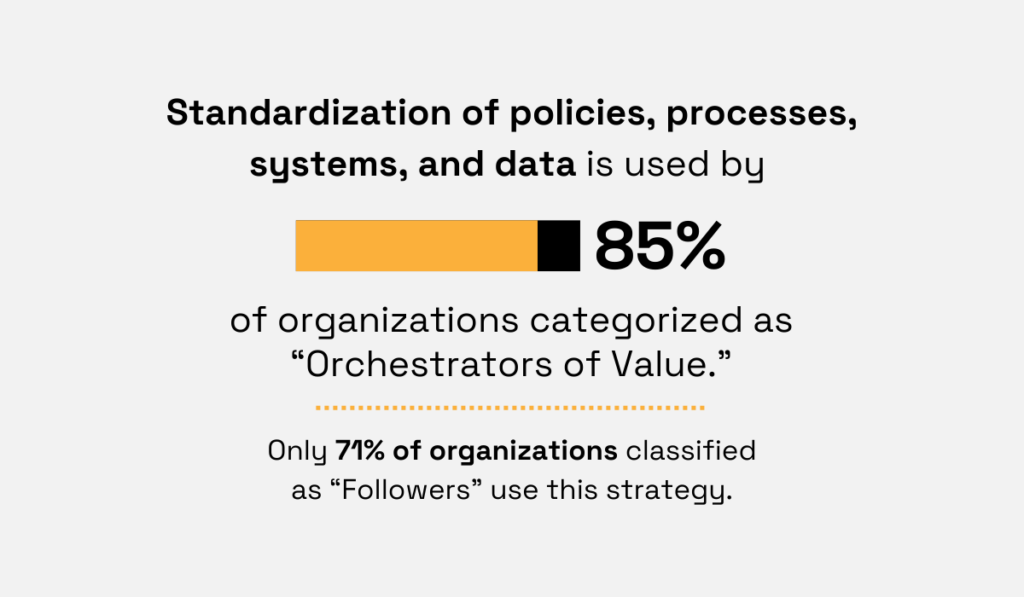
Illustration: Veridion / Data: Deloitte
The benefit of standardizing evaluation criteria during supplier onboarding is twofold: it increases efficiency and consistency in supplier selection.
Standardized criteria give procurement teams direction on what to look for when assessing suppliers, rather than evaluating each one on a case-by-case basis.
It also sets key requirements for whether a vendor should move forward in the onboarding process, aligning supplier selection with broader company goals.
Some evaluation parameters you might want to consider are illustrated below.
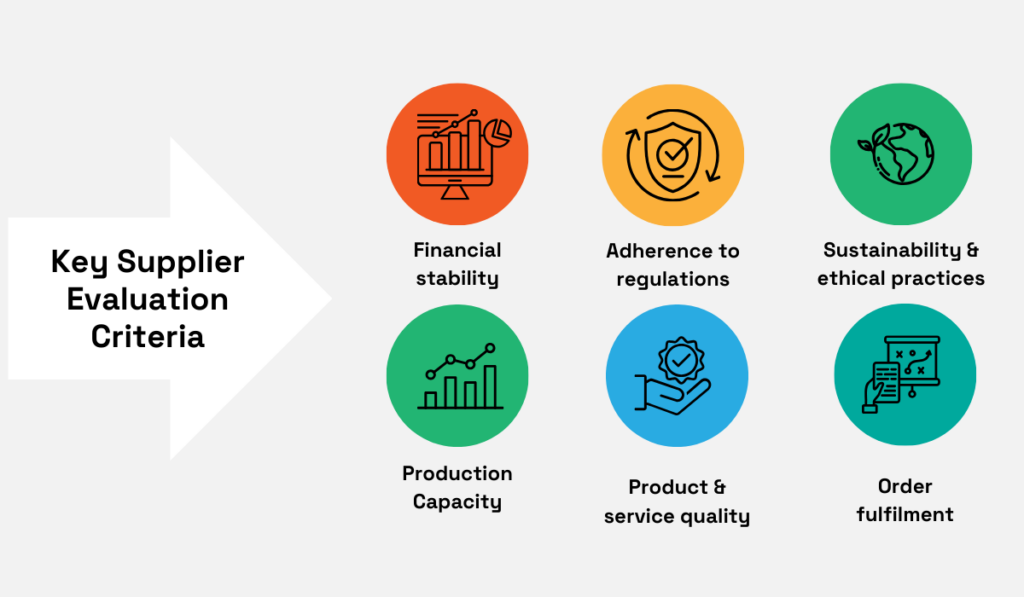
Source: Veridion
Of course, the specific criteria will depend on your business needs and objectives, but the ones listed are some common considerations.
For each parameter, you’ll need to gather data—typically historical data, reports from suppliers, and any certifications the company holds.
For example, when evaluating supplier quality, you might look for ISO 9001 certification, an internationally recognized standard for quality management systems.

Source: ISO
Frameworks like ISO 20400 for sustainable procurement are also useful if your organization is focused on complying with the growing number of ESG regulations.
For other types of criteria, such as financial information, you can examine financial reports and historical performance, or request suppliers to provide relevant documents and reports.
Depending on the metric that matters most to your business, you may also want to implement weighted scoring, where each criterion is assigned a certain weight.
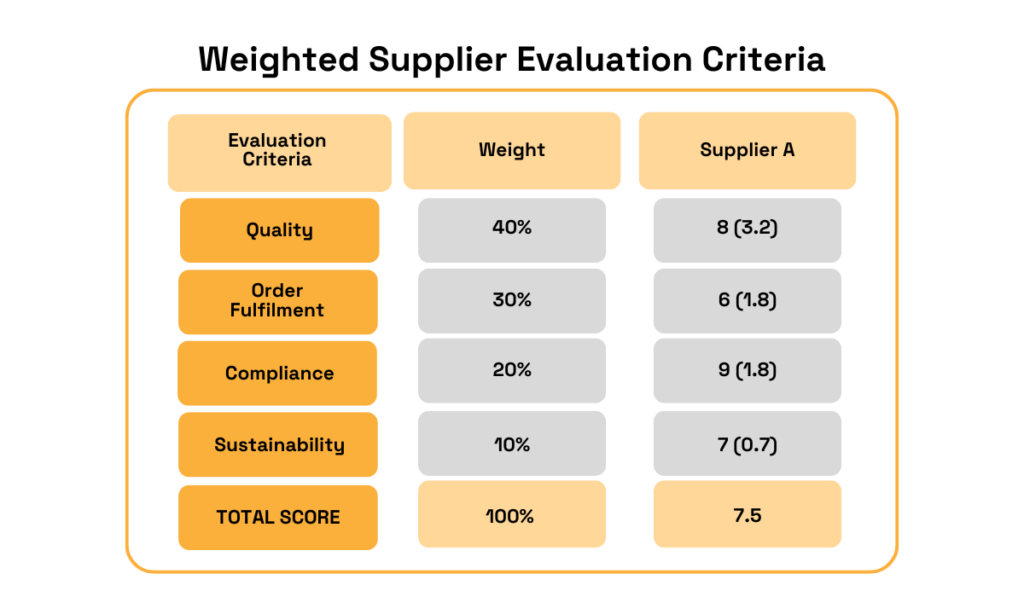
Source: Veridion
This method is great for assigning scores to suppliers, and, more importantly, comparing them against one another.
For instance, if quality is more important than cost, you can assign it a higher weight to better evaluate and rank potential suppliers.
The key takeaway here is that by establishing clear evaluation criteria upfront, you ensure consistency during the onboarding process and enable a fair, objective assessment of potential suppliers.
After establishing your evaluation criteria, the next step is to collect data and assess potential vendors.
One best practice that significantly optimizes this process is centralizing your supplier information.
This means storing all relevant supplier data in a single, easily accessible location, creating a “single source of truth” that streamlines the entire onboarding journey.
While it may seem simple, centralizing supplier information offers a wide range of benefits, particularly when compared to scattered data.
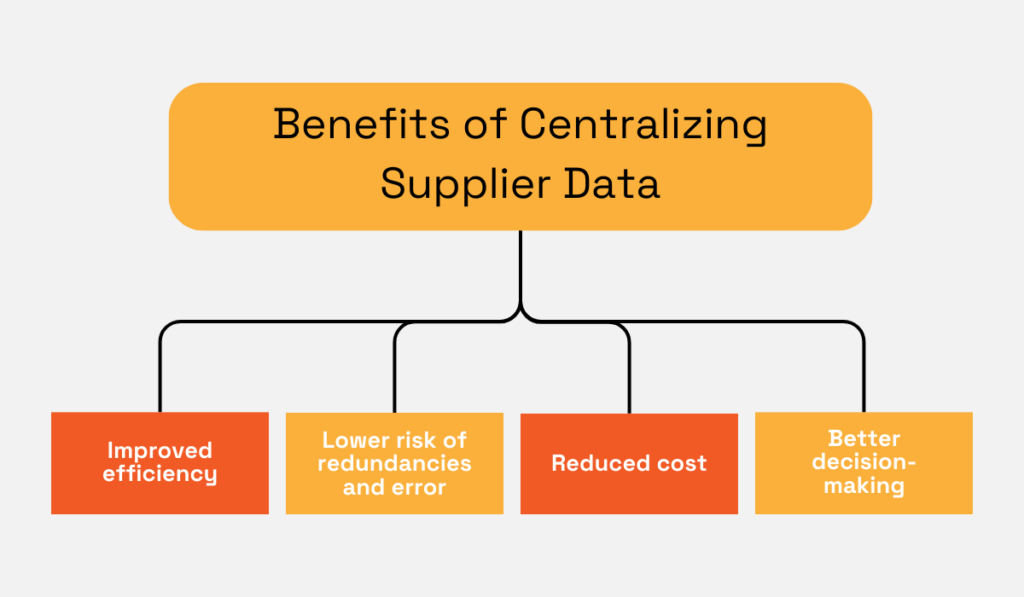
Source: Veridion
For instance, instead of manually transferring crucial onboarding documents like reports and questionnaires from disparate sources, which increases the risk of errors, a centralized system allows for more consistent and efficient onboarding.
This approach also helps reduce duplicate data entries and cut down manual workloads.
But more importantly, it improves data visibility and accessibility for all relevant stakeholders.
So, how can you effectively centralize your supplier information?
One option is to leverage onboarding platforms like SupplierGateway, which offer complete self-service onboarding features for suppliers.

Source: SupplierGateway
These platforms automatically collect essential documents and completed questionnaires, eliminating the need for constant manual requests.
All received data is stored within the platform, making it readily available throughout the onboarding process.
However, if your organization already uses a dedicated supplier onboarding system and you’re focused on centralizing existing data, specialized Supplier Information Management (SIM) systems can be valuable.
You’ve probably heard of all-in-one systems like GEP SMART, which have specific capabilities for collecting, storing, accessing, and updating supplier databases.

Source: GEP
Other widely used systems with SIM capabilities include SAP Ariba, Coupa, Jaggaer, and Zycus.
These platforms are popular across various industries for their robust features and seamless integration capabilities with other enterprise tools.
A significant advantage of these systems is that once your suppliers are fully onboarded, their records can be maintained within the system.
This allows you to leverage powerful reporting and analytics features to continuously monitor supplier performance.
In other words, centralizing your vendor data is a long-term investment.
It builds upon existing records to create a comprehensive supplier database that evolves and grows alongside your business.
This data repository becomes an invaluable resource for managing supplier relationships, optimizing procurement processes, and driving overall supply chain efficiency.
So far, we’ve touched on a few tools that support supplier onboarding.
Let’s take a closer look at these technologies, as they play a critical role in improving both the effectiveness and efficiency of the onboarding process.
There are several categories of supplier onboarding technologies, including:
Some of these have already been mentioned, but let’s explore additional examples and their benefits.
Take the case of MarketDojo, a supplier onboarding platform used by Ground Control, a leading UK landscaping and external solutions provider.

Source: MarketDojo
Ground Control used the platform to automate key parts of its onboarding process.
One of the main improvements was creating multiple supplier questionnaires within the system, with a dynamic workflow that determined which questions were sent to which suppliers.
This targeted approach allowed them to send suppliers questions that only apply to them and collect all the answers instantly, instead of relying on spreadsheets.
This boost in efficiency was just one of the many benefits.
You can explore the full case study for deeper insights, but the key takeaway is clear: purpose-built onboarding platforms can significantly streamline your workflows.
Of course, no conversation about technology investment is complete without mentioning Artificial Intelligence.
According to data from The Hackett Group, the vast majority of procurement executives are turning to AI to drive more efficiency and growth within their organizations.
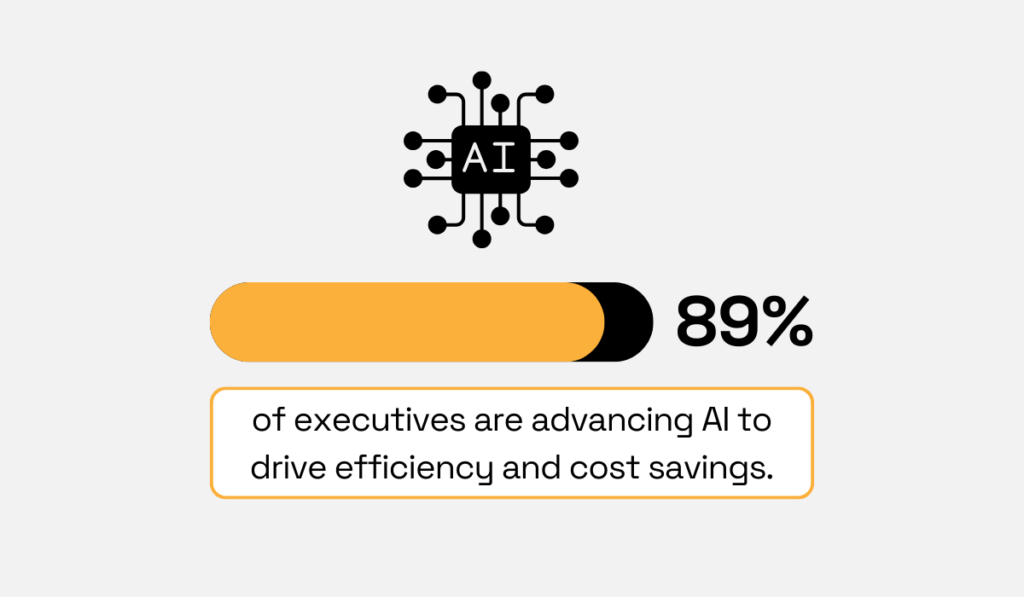
Illustration: Veridion / Source: The Hackett Group
In supplier onboarding, AI can automate tasks such as data collection, extraction, and verification.
It can also power chatbots that support onboarding inquiries and improve supplier communication.
To highlight an example, we can showcase our AI-powered data engine Veridion.
Veridion streamlines the onboarding process by automating the collection and enrichment of supplier data.
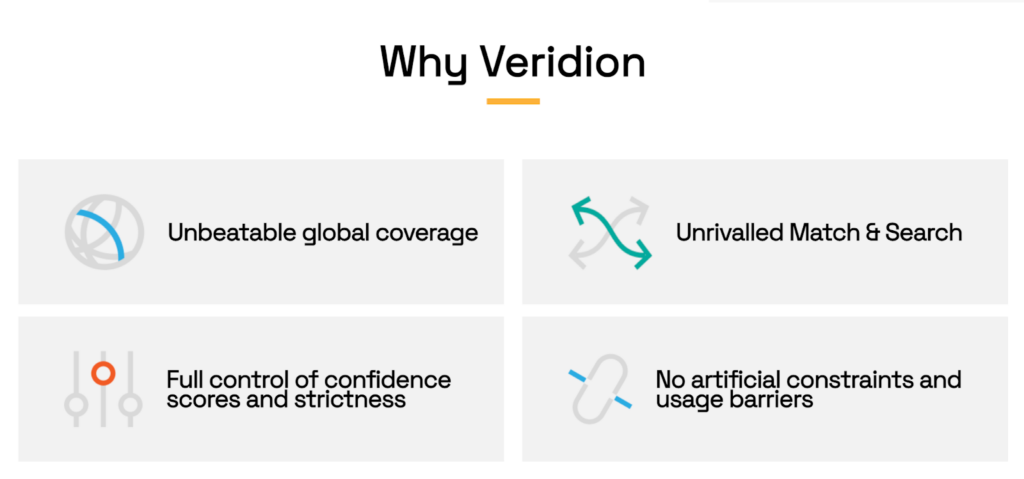
Source: Veridion
It helps gather over 60 data points per supplier, including company details, financial performance, certifications, and ESG ratings, ensuring data accuracy and completeness.
Using sophisticated AI algorithms, Veridion scans the entire internet to collect real-time data from company websites, news articles, filings, social media, and industry databases.
One of Veridion’s standout features is its Match & Enrich service.
This service identifies and matches supplier records with reliable data sources, filling in any data gaps during onboarding.
Source: Veridion
Let’s say you need to verify ESG compliance before onboarding a supplier.
Veridion can instantly deliver dozens of ESG data points, updated regularly by AI, to help you make confident decisions.
This lets you quickly assess a supplier’s sustainability performance and make informed decisions.
Ultimately, investing in the right technology transforms supplier onboarding from a manual, time-consuming task into a streamlined, automated, and insight-driven process.
Transparent and strong communication with your suppliers is always important, but it’s especially critical during onboarding.
After all, this initial stage sets the tone for the entire relationship.
Clear communication is essential for addressing questions, clarifying expectations, and ensuring a smooth transition.
Unfortunately, HICX’s 2024 Voice of the Supplier survey reveals that nearly all suppliers feel communication needs improvement.
In fact, almost half said this is true even when dealing with their key customers.
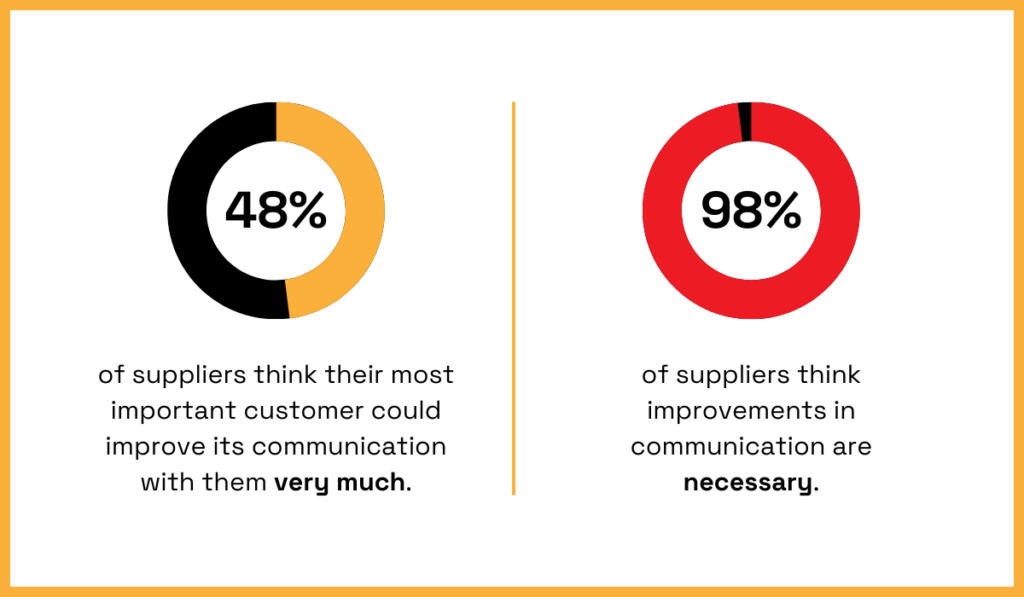
Illustration: Veridion / Data: HICX
Luckily, improving communication is entirely within reach.
It starts with clearly defining communication channels, specifying which tools will be used, and outlining the purpose of each one.
Here’s an example of what this setup might look like:
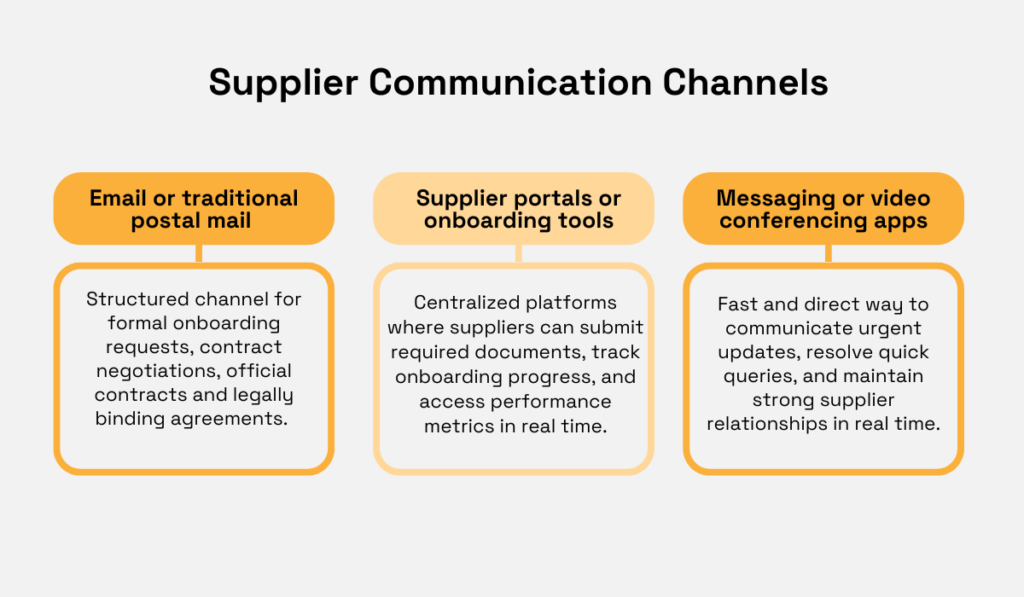
Source: Veridion
When suppliers and customers share an understanding of how and why these channels are used, it can significantly improve organization and efficiency.
But it goes further than that.
When asked about successful long-term supplier partnerships, Caitlyn Lewis, founder and CEO of Supplier Day, a platform for supplier events, offered a powerful perspective:

Illustration: Veridion / Quote: CPO Strategy
This is a bold statement, but one worth careful consideration.
Lewis further emphasizes that in today’s competitive landscape, supplier relationships are often the true value driver and differentiating factor for businesses.
That’s why clear communication and collaboration must be a priority from the very beginning.
By fostering transparency and openness during onboarding, you create an environment of trust and set the stage for strong, strategic, and long-lasting partnerships.
Thorough risk assessments during onboarding are essential for protecting your organization from potential disruptions in the long term.
After all, prevention is the best risk mitigation strategy.
This is especially important in today’s increasingly turbulent business environment.
Consider QIMA’s 2025 Global Sourcing Survey, which surveyed over 650 businesses with international supply chains.
A key insight from this survey reveals that organizations are more worried about disruptions than ever before.
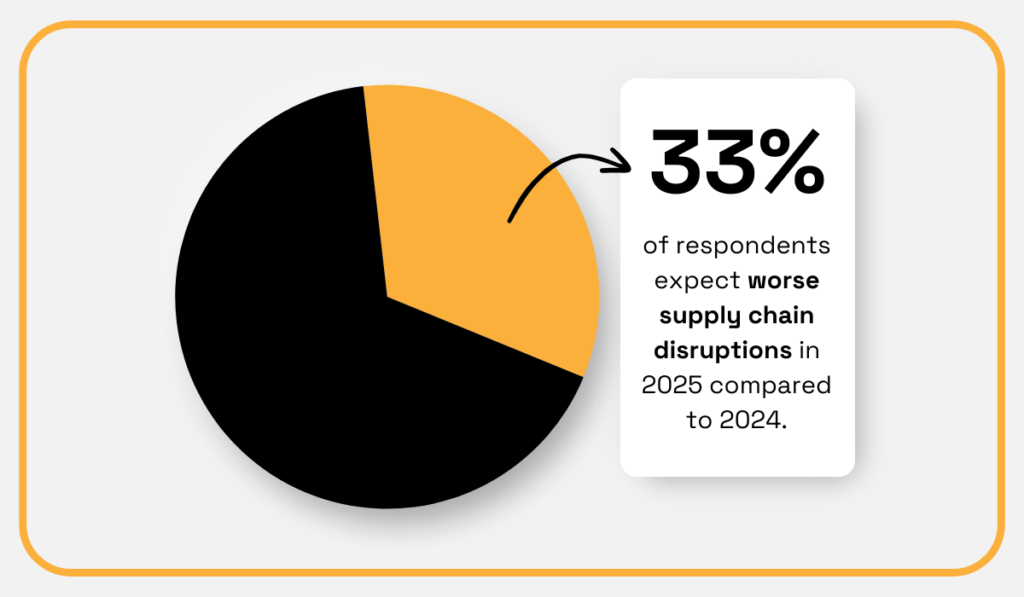
Illustration: Veridion / Data: QIMA
This marks a sharp increase from the previous year, when only 18% of respondents anticipated more disruptions compared to the year prior.
Given this trend, it’s more important than ever to assess potential suppliers across multiple risk dimensions, including:
As you can see, the list of potential risks is extensive, but it’s essential to consider all of them to protect your business.
As Nojus Bendoraitis, co-founder of cybersecurity platform CyberUpgrade, explains, this safeguards your operations and, in certain cases, ensures your compliance with emerging regulations.
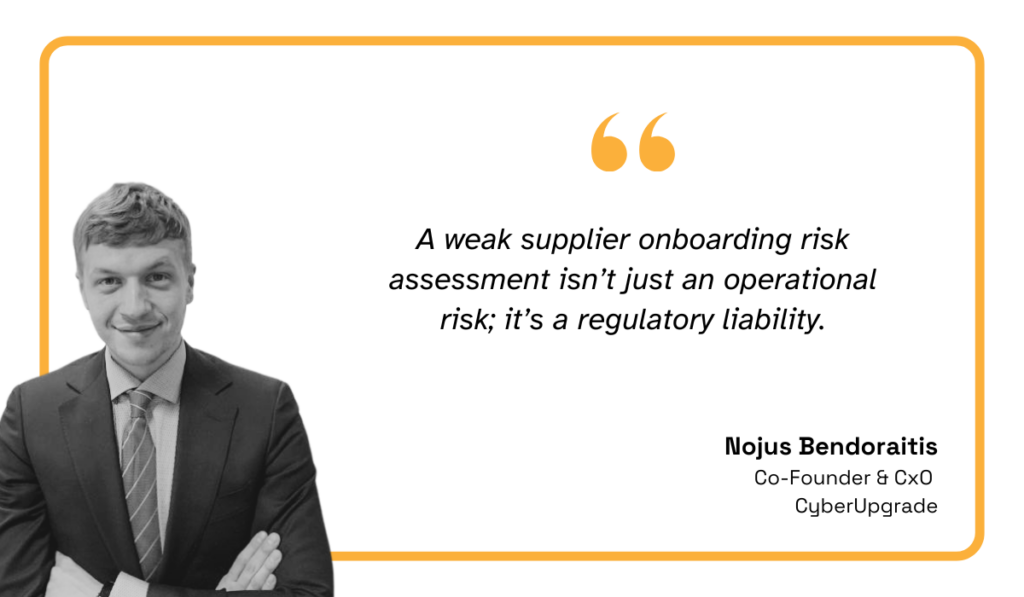
Illustration: Veridion / Quote: CyberUpgrade
For example, conducting a cybersecurity risk assessment during onboarding prevents a vendor’s security vulnerabilities from becoming your own.
It also ensures you’re prepared for regulations like the Digital Operational Resilience Act (DORA).
Similarly, with growing pressure from sustainability regulations, using ESG data platforms like Veridion can help you determine whether suppliers meet ethical and environmental standards.
Admittedly, assessing multiple risk types across many vendors can feel overwhelming, especially with limited resources.
That’s where third-party risk platforms like Venminder help.

Source: Venminder
Tools like Venminder can serve as a central repository for your vendor data and facilitate due diligence before finalizing supplier contracts.
They enable risk- and vendor-specific workflows for risk assessments, including creating customizable questionnaires, streamlining data collection and review, and automating high-risk vendor detection.
Of course, while software can significantly simplify the risk assessment process, technology is most effective when combined with a well-defined risk management strategy.
With the right mix of software and strategic oversight, you can make smarter onboarding decisions and protect your supply chain from potential disruptions.
This wraps up our exploration of the five best practices for successful supplier onboarding.
We’ve covered a range of strategies, from setting clear vetting criteria and centralizing supplier data to fostering open communication and conducting thorough risk assessments.
We also highlighted how the right technologies can streamline and strengthen each of these steps.
Hopefully, you’ve gained valuable insights into building a more efficient and resilient supply chain through effective onboarding.
Now it’s time to put these practices into action and establish better supplier partnerships right from the start.